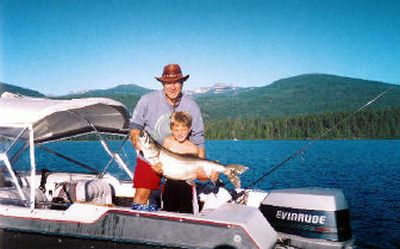Ins, outs of Panhandling

Lake Coeur d’Alene has become the darling of kokanee anglers since the fishery peaked with good numbers and hefty average sizes in 2003.
This year the kokanee population is expected to be down a little from ideal numbers but size running 13-15 inches should once again put anglers in blueback heaven.
Typically, the kokanee bite starts at the south end of the lake in the spring and gradually works north through the lake. By late summer, most of the action is at the north and into Wolf Lodge Bay.
Other good Coeur d’Alene fisheries include:
“Chinook, caught year-round, are doing fairly well now at the north end of the lake along the deep channel from Arrow Point to Mica Bay.
“Northern pike have stabilized from their boom years in the 1980s and ‘90s. “Pike aren’t as plentiful as they used to be, at least for now, because it turns out they’re fairly vulnerable to weather and lake level fluctuations,” said Ned Horner, Idaho Fish and Game Department regional fisheries manager. “But Coeur d’Alene still produces a fair number of pike, including some 20-plus pounders.”
Northerns tied into weed beds and specific types of weed beds, curly leaf pond weed for instance , where you find that vegetation you’ll find pike.
Going for the silver
Spirit Lake, a well-known kokanee hot spot north of Coeur d’Alene, is even better.
The season was curtailed for a few years to stem overfishing. “The kokanee have come back enough to reopen it year-round, but we left the 15- fish limit in place,” Horner said.
“The kokanee are running about 10 inches, which is normal size for North Idaho kokanee, and the fishing should hold up through the summer.”
Other Panhandle kokanee lakes include Hauser, Mirror and Lower Twin. “Were stocking at low densities in these lakes and the result is 2-year-old fish that can be 14-16 inches,” Horner said.
Cutthroat business
Patience will be an even more important virtue this year for anglers eager to get out on North Idaho cutthroat trout streams.
“We were spoiled with the low snowpack last year that let us get out fishing when the stream season opened at the end of May,” said Horner.
“This year we have a normal snowpack and, with the cool spring we’ve been having, it’s likely to be well into June before the water levels settle down.”
But when they do, the cutthroat trout fishing should be outstanding.
Both the Coeur d’Alene and St. Joe rivers have catch-and- release sections that help preserve the fishery capital despite a growing interest in fishing quality trout streams.
“Last year our studies found record-high cutthroat densities for both the Coeur d’Alene and St. Joe,” Horner said. “Unless something really unusual happens with the spring runoff, we should have excellent fishing again this year.”
Priestly macks
Mackinaw are the bread and butter for anglers at Priest Lake.
“I’d say the fishery is 99 percent lake trout,” Horner said. “Their diet is primarily mysis shrimp, so they are some of the best eating lake trout in the world, with deep orange flesh.”
The two top methods for catching Priest Lake macks are deep-water jigging and trolling with downriggers, but you must use a fish finder and put your lures where the fish are.
“Last April, when the water temperatures were pretty cool, I took some friends out and we thought we could find them jigging at 60 feet,” Horner said. “But we didn’t start getting fish until we were 140 feet deep and we went down from there.”
No-stretch line and glow-in-the-dark jigs with cut bait or nightcrawlers are helpful, too, he said.
“Lake trout are one of the easiest fish to catch once you get dialed in to them. But I have some friends who bought downriggers, put them down 50 feet and trolled like that all day. They didn’t get a bump. To be efficient with lake trout, you have to be within one or two feet from the bottom.
The limit is six fish a day.
While Upper Priest Lake is generally managed as a catch- and-relese fishery for the area’s last stronghold for cutthroat, bull trout and kokanee, lake trout are invading the lake.
“So we’re allowing anglers to keep lake trout in Upper Priest,” Horner said. “Fish right on the bottom or jig off rocky points and you might get them, although the fishing will be a lot better in the lower lake.”
Quality considerations
Bonner Lake east of Bonners Ferry is North Idaho’s only small lake with a ban on bait and gasoline motors, plus a restrictive trout limit geared to quality trout fishing.
“Unfortunately, bass and sunfish are taking over and Bonner hasn’t provided the quality fishing we’d hoped for,” said Horner.
This summer, the Fish and Game plans to ask anglers if they would like to try converting other Panhandle lakes to quality management.
“We know there’s a demand,” he said. “A lot of North Idaho anglers drive over to Eastern Washington to fish quality fisheries like Lake Lenore.”
No-hassle fishing
The Idaho Panhandle has established 14 “family fishing waters” geared to making it as simple as possible to take kids fishing. These waters have:
“Year-round seasons.
“Limit of six trout and six bass.
“No limits on other fish species.
“No length limits.
Use any standard fishing gear and you’re ready to go at these family lakes: Antelope, Bull Moose, Elsie, Fernan, Granite, Jewel, Kelso, Lower Glidden, Round, Sinclair and Smith, and Day Rock, Post Falls Park and Steamboat ponds.
Details: Page 22 of the 2006-2007 Idaho Fishing Regulations. Note, however, that electric motors are allowed on Round Lake.